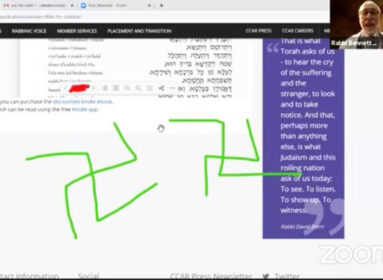Recently, the Ledger received a provocative article written by Dr. Jim Mellett of New Fairfield that not only asserts that America was discovered by a Portuguese Sephardic Jew named Cristóvão Colón, but also that the very person known as Christopher Columbus never existed. True or false? We leave that for you to decide. But we thought the article interesting enough to share, as we prepare to celebrate Columbus Day on Monday, Oct. 14. Note: The article includes references that, for space considerations, are not listed here. However, they can be found on the Ledger’s website at HYPERLINK “http://www.jewishledger.com” www.jewishledger.com.
By James S. Mellett, PhD
Christopher Columbus is not just a mythical figure. He is a myth; he never existed except in the minds of 16th century forgers in the Vatican, Italy, and other countries. Apparently, writing Columbus biographies was a cottage industry in Italy and elsewhere. The belief that “Columbus was an Italian Catholic born in Genoa” ranks as one of the greatest historical frauds ever perpetrated. It has persisted over 500 years and should be put to rest.
Christopher Columbus was not the name of the man who discovered the Americas. In all documents and treaties signed by him, he used the name Cristóvão Colón, and never Christopher Columbus. The Catholic Church was unwilling to accept that a Jew discovered the New World, especially following its role in the ruthless, violence–filled Inquisition and it did everything in its power to turn him into an Italian. The Vatican published a Papal Bull in 1493, with Colón’s name on the first line, and his siglum or trademark, with signature at the end. This was followed by a forged version that substituted “Christofer Columbo” at the top, and a badly bungled siglum at the end.
The “Columbus” Myth
How did the mythical Italian Catholic “Christopher Columbus,” come into being? He was allegedly born to a family of wool carders in Genoa in 1415, variously described as having blonde or red hair, with or without freckles, but with no contemporary likenesses available. All his portraits are posthumous. It is puzzling that someone stemming from a line of craftsmen could move so freely among kings, nobles, and princes in Spain and Portugal. No contemporary historians have been able to explain this anomaly. But there are many more anomalies to follow that really cast doubt on the existence of one “Christopher Columbus” and clearly point to another persona entirely.
The name “Columbo” is derived from the Latin Columba, the dove; in Christianity, it is a symbol of the Holy Spirit. The surname was widespread not only in Italy, but in other European cultures as well, so there was no shortage of Columbuses that “biographers” could insert into different time and place slots to flesh out the fictitious histories of the man. The profusion of the name is a residue of a 9th century Catharian movement/heresy, but that is another long story.
The true Columbus, Cristóvão Colón, was born in Cuba, Alantejo, Portugal in 1448, not Genoa, Italy, the illegitimate son of Dom Fernando, Duke of the city of Beja. His mother was a Sephardic Jew named Isabel Gonçalves Zarco. When he addressed personal letters he placed a small cross in the center of the letterhead, and the Hebrew letters Bet and Hay, short for Baruch HaShem, “Blessed is God” on the upper left, an odd habit for an Italian Catholic. Because it is written in script, an alternative is “Bless you” in Hebrew, Baruch Tiyeh, which would make the letters Bet and Tav; Tav looks like Khet with a little foot, so they can also be easily confused.
On March 31, 1492, Colón heard trumpets blaring in the town square in Madrid. The Decree of Alhambra (Edict of Expulsion) was read to the crowd telling them that all Jews and Muslims were being expelled from Spain, unless they converted to Christianity within four months. Colón had time to skip town because he was a Converso and might be subject to a challenge about his Christianity. He left Spain on August 2, 1492, hours ahead of the Spanish Inquisition, which might have arrested him.
His grandfather was the navigator João Gonçalves Zarco, who prayed at a synagogue in the same town that held the Orders of the Temple (Knights of Templar). He became a Christian and joined the Order of Christ. King John I’s son was Prince Henry the Navigator, who ran a school of navigation, and obtained a wealth of maps (mappa mundi) from his brother, Pedro. Prince Henry was convinced a route to India and China could be found by sailing eastward around the horn of Africa. Here the plot thickens: Colón may have been part of a plan hatched by Portugal’s King John II to mislead the Spanish into believing that a route to “the indies” could be found by sailing westward, and dragging out a huge red herring that Spain fell for. These discoveries greatly enriched Spain, and would have blunted any effort to attack Colón for deceiving the crown.
Colón presented Queen Isabella and King Ferdinand of Spain with a 1474 map of the Atlantic Ocean made by Pablo Toscanelli. The map was wildly inaccurate and showed Cippango (Japan) a stone’s throw west of the Azores, with Katay (China) and India not too far beyond. Because Toscanelli had an excellent reputation as a cartographer, the Royals were convinced, and supported Colón fully for his expedition to sail westward. The Spanish royals gave their blessing, but Sephardic Jews provided the funding, which they would not have done for an Italian.
Ironically, Portuguese sailors had already landed at Labrador (named after Joāo Lavrador) and Newfoundland, which they named Cod Island, some 40 years before Colón “discovered” America. The Portuguese had explored the Caribbean years before Colón, so he knew there was a new continent far to the west.
When he left Spain in 1492, he did not sail directly westward, which would have taken him directly to the New World, but took a detour southwest to the Canary Islands, Latitude 29° N. Columbus historians claim he did so to pick up supplies and refit his ships, but his real reason was to sail just south the parallel of the Canaries, which separated Spanish and Portuguese control of the seas. He sailed in Portuguese waters all the way to the Caribbean. If he were working for Spain, why did he do that? And why did he return to Portugal first to meet King John II and not Spain?
Falsification of the Columbus Legend
The little anomalies noted above makes one pause and think about whether the discoverer of America was an Italian Catholic. For example, the star tables used by “Columbus” on his voyage were written in Hebrew. The originals are archived in the Jewish Theological Seminary in New York City. An Italian Catholic who could read Hebrew?
If he were working for Spain, the first thing he would have done was to plant the flag of Spain in the New World, as well as a large cross or crucifix. Yet there were no Catholic priests in his crew, but there were many Jews who were Conversos. The first person to set foot on American soil was a Sephardic Jew named Luis de Torres. He was fluent in Hebrew, Aramaic, and Castilian and served as an interpreter on board the ships because of the crew’s diversity.
Every place name he used in the Caribbean and western Atlantic had Portuguese roots. He did not name a single place after Genoa, Rome, or any Italian locale or person, nor were any places named after Spanish cities or royalty. If he were an Italian working for Spain, that is more than an oddity. Again, no historians have ever explained this anomaly.
But the real blow comes when one examines his siglum, his trademark and signature. More than anything else, this demonstrates a Portuguese Sephardic Jew as the person who discovered the New World.
In Catalan, the letter “x” is pronounced “sh.” The group of letters together, “x.m.y” are pronounced “Sh’ma Yis-ra-el” or “Hear O Israel.” That phrase would be followed by “Adonai E-lo-hei-nu,” part of a Hebrew proclamation of faith. Why would an Italian Catholic write this?
Colon’s siglum echoes Cabalistic styles. His signature (Christoferens) is preceded by a colon (:), and ends with a full stop (./), signifying another colon, the root of his name. The Vatican forgery was totally erroneous. No mainstream historians have ever mentioned or engaged this question.
But Colón had a more substantive reason for “discovering” a continent he already knew was on the west side of the Atlantic. He often quoted the prophet Isaiah, who predicted (LXV:17) “…the discovery of new lands…for the exultation of Jerusalem…,” and St. John the Evangelist, who wrote (Apocalypse XXI:1, 2, 24) of “… a new land of the West; a new Jerusalem….” He wanted to find a “Promised Land” for those who escaped the Inquisition. According to Barreto (p. 506) “His aim was the salvation of the Jews. It was also a Christian and Templar mission.”
A resident of New Fairfield, Jim Mellett received a PhD in geology from Columbia University. He has written scores of scientific articles on a number of aspects of earth history. “Whereas conventional historians read pages of books and documents for their research,” says Mellett, “geologists interpret layers of rock that record an ever-changing environment.” He was featured in a National Geographic Special on Prehistoric Predators called “Razor Jaws.”
Of his credibility in discussing matters related to the Catholic church, he says: “As someone who had 16 years of Catholic education, I am more than familiar with Church doctrine, doctrinal changes, and the numerous Church Councils that met over centuries.”
Comments can be addressed to Jim Mellett at j.s.mellett@gmail.com.








 Southern New England Jewish Ledger
Southern New England Jewish Ledger











